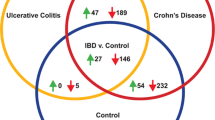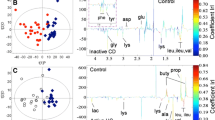Abstract
Inflammatory bowel disease (IBD), which mainly comprises ulcerative colitis (UC) and Crohn’s disease (CD), is a common chronic intestinal inflammatory disease that affects the ileum, rectum, and colon. Currently, the diagnosis of IBD is based on clinical history, physical examination and complementary diagnostic tests. It is challenging for physicians to make a definitive diagnosis. This study aimed to analyze the variation in amino acid metabolites in IBD serum and to identify potential predictive biomarkers of IBD diagnosis and progression. Serum samples were collected from 158 UC patients, 130 CD patients and 138 healthy controls (HCs). The 37 amino acids in serum were determined by ultra-high-pressure liquid chromatography coupled to a mass spectrometer. A panel of three-amino-acid metabolites (taurine, homocitrulline and kynurenine) was identified as a specific biomarker panel of IBD. Receiver operating characteristic analysis (ROC) showed that the panel had a sensitivity of 88.4% with a specificity of 84.6% for discriminating CD patients from UC patients. The biomarkers identified are increased in CD compared to UC. Our approach demonstrated a strong relationship between serum amino acid levels and IBD. We successfully identified serum amino acid biomarkers associated with CD and UC. The biomarker panel has potential in clinical practice for IBD diagnosis and will provide new insights into IBD pathogenesis.






Similar content being viewed by others
Availability of data and materials
The data and materials used or analyzed during the current study are available from the corresponding author Prof. Shijia Liu (yfy0039@njucm.edu.cn) on reasonable request.
References
Abraham C, Cho JH (2009) Inflammatory bowel disease. N Engl J Med 361:2066–2078
Alatab S, Sepanlou SG, Ikuta K, Vahedi H, Bisignano C, Safiri S et al (2020) The global, regional, and national burden of inflammatory bowel disease in 195 countries and territories, 1990–2017: a systematic analysis for the global burden of disease study 2017. Lancet Gastroenterol Hepatol 5:17–30
Ananthakrishnan AN (2015) Environmental risk factors for inflammatory bowel diseases: a review. Dig Dis Sci 60:290–298
Bao X, Feng Z, Yao J, Li T, Yin Y (2017) Roles of dietary amino acids and their metabolites in pathogenesis of inflammatory bowel disease. Mediat Inflamm 2017:6869259
Bitton A, Peppercorn MA, Antonioli DA, Niles JL, Shah S, Bousvaros A et al (2001) Clinical, biological, and histologic parameters as predictors of relapse in ulcerative colitis. Gastroenterology 120:13–20
Brestoff JR, Artis D (2013) Commensal bacteria at the interface of host metabolism and the immune system. Nat Immunol 14:676–684
Buisson A, Gonzalez F, Poullenot F, Nancey S, Sollellis E, Fumery M et al (2017) Comparative acceptability and perceived clinical utility of monitoring tools: a nationwide survey of patients with inflammatory bowel disease. Inflamm Bowel Dis 23:1425–1433
Cho JH (2008) The genetics and immunopathogenesis of inflammatory bowel disease. Nat Rev Immunol 8:458–466
Cosnes J, Gower-Rousseau C, Seksik P, Cortot A (2011) Epidemiology and natural history of inflammatory bowel diseases. Gastroenterology 140:1785–1794
Costa F, Mumolo MG, Ceccarelli L, Bellini M, Romano MR, Sterpi C et al (2005) Calprotectin is a stronger predictive marker of relapse in ulcerative colitis than in Crohn’s disease. Gut 54:364–368
D’haens G, Ferrante M, Vermeire S, Baert F, Noman M, Moortgat L et al (2012) Fecal calprotectin is a surrogate marker for endoscopic lesions in inflammatory bowel disease. Inflamm Bowel Dis 18:2218–2224
Franzosa EA, Sirota-Madi A, Avila-Pacheco J, Fornelos N, Haiser HJ, Reinker S et al (2019) Gut microbiome structure and metabolic activity in inflammatory bowel disease. Nat Microbiol 4:293–305
Haroon E, Miller AH, Sanacora G (2017) Inflammation, glutamate, and glia: a trio of trouble in mood disorders. Neuropsychopharmacology 42:193–215
Huang H, Fang M, Jostins L, Mirkov MU, Boucher G, Anderson CA et al (2017) Fine-mapping inflammatory bowel disease loci to single-variant resolution. Nature 547:173–178
Jagt JZ, Struys EA, Ayada I, Bakkali A, Jansen EEW, Claesene J et al (2021) Fecal amino acid analysis in newly diagnosed pediatric inflammatory bowel disease: a multicenter case-control study. Inflamm Bowel Dis 28:755–763
Jukic A, Bakiri L, Wagner EF, Tilg H, Adolph TE (2021) Calprotectin: from biomarker to biological function. Gut 70:1978–1988
Kawamoto A, Takenaka K, Hibiya S, Ohtsuka K, Okamoto R, Watanabe M (2022) Serum leucine-rich α glycoprotein: a novel biomarker for small bowel mucosal activity in Crohn’s disease. Clin Gastroenterol Hepatol 20:e1196–e1200
Kiely CJ, Pavli P, O’brien CL (2018) The role of inflammation in temporal shifts in the inflammatory bowel disease mucosal microbiome. Gut Microbes 9:477–485
Knights D, Lassen KG, Xavier RJ (2013) Advances in inflammatory bowel disease pathogenesis: linking host genetics and the microbiome. Gut 62:1505–1510
Krzesiek E, Kofla-Dlubacz A, Akutko K, Stawarski A (2021) The incidence of inflammatory bowel disease in the paediatric population in the district of lower Silesia, Poland. J Clin Med 10:3994
Lambert IH, Kristensen DM, Holm JB, Mortensen OH (2015) Physiological role of taurine–from organism to organelle. Acta Physiol (oxf) 213:191–212
Nelson RL, Schwartz A, Pavel D (2001) Assessment of the usefulness of a diagnostic test: a survey of patient preference for diagnostic techniques in the evaluation of intestinal inflammation. BMC Med Res Methodol 1:5
Nikolaus S, Schulte B, AL-Massad N, Thieme F, Schulte DM, Bethge J et al (2017) Increased tryptophan metabolism is associated with activity of inflammatory bowel diseases. Gastroenterology 153:1504–1516
Platten M, Nollen EAA, Rohrig UF, Fallarino F, Opitz CA (2019) Tryptophan metabolism as a common therapeutic target in cancer, neurodegeneration and beyond. Nat Rev Drug Discov 18:379–401
Ristvedt SL, Mcfarland EG, Weinstock LB, Thyssen EP (2003) Patient preferences for CT colonography, conventional colonoscopy, and bowel preparation. Am J Gastroenterol 98:578–585
Schoepfer AM, Trummler M, Seeholzer P, Seibold-Schmid B, Seibold F (2008) Discriminating IBD from IBS: comparison of the test performance of fecal markers, blood leukocytes, CRP, and IBD antibodies. Inflamm Bowel Dis 14:32–39
Schoepfer AM, Beglinger C, Straumann A, Trummler M, Vavricka S, Bruegger LE et al (2010) Fecal calprotectin correlates more closely with the simple endoscopic score for Crohn’s disease (SES-CD) than CRP, blood leukocytes, and the CDAI. Am J Gastroenterol 105:162–169
Scoville EA, Allaman MM, Brown CT, Motley AK, Horst SN, Williams CS et al (2018) Alterations in lipid, amino acid, and energy metabolism distinguish Crohn’s disease from ulcerative colitis and control subjects by serum metabolomic profiling. Metabolomics 14:17
Shimizu M, Zhao Z, Ishimoto Y, Satsu H (2009) Dietary taurine attenuates dextran sulfate sodium (DSS)-induced experimental colitis in mice. Adv Exp Med Biol 643:265–271
Steenholdt C, Jensen JT, Brynskov J, Møller AM, Limschou AC, Konge L et al (2022) Patient satisfaction of propofol versus midazolam and fentanyl sedation during colonoscopy in inflammatory bowel disease. Clin Gastroenterol Hepatol 20:559–568
van Rheenen PF, Van de VE, Fidler V (2010) Faecal calprotectin for screening of patients with suspected inflammatory bowel disease: diagnostic meta-analysis. BMJ 341:c3369
Vermeire S, Van Assche G, Rutgeerts P (2006) Laboratory markers in IBD: useful, magic, or unnecessary toys? Gut 55:426–431
Walker A, Schmitt-Kopplin P (2021) The role of fecal sulfur metabolome in inflammatory bowel diseases. Int J Med Microbiol 311:151513
Acknowledgements
We thank all the study participants who made this study possible, and all the staff in the first affiliated hospital of Nanjing University of Traditional Chinese Medicine who helped us in the collection of samples.
Funding
This work was supported by the National Natural Science Foundation of China (No. 82074241), Jiangsu Provincial Hospital of Traditional Chinese Medicine (No. y2021rc36) and Nanjing Municipal Science and Technology Bureau (No. 202110023).
Author information
Authors and Affiliations
Contributions
All authors contributed to the study conception and design. GZ and SL conceived the initial experimental conception and design; SZ, HL, PW and QH performed material preparation, data collection and analysis; SZ, HL and ZJ wrote the draft of the manuscript; QS and SL revised the manuscript critically for important intellectual content; GZ, TL and SL helped perform the analysis with constructive discussions. All authors commented on previous versions of the manuscript. All authors read and approved the final manuscript.
Corresponding author
Ethics declarations
Conflict of interest
The authors declare no potential conflicts of interest relevant to this article.
Ethical approval
All procedures performed in studies involving human participants were in accordance with the ethical standards of the institutional and national research committee and with the 1984 Helsinki declaration and its later amendments or comparable ethical standards. This study was approved by the Institutional Review Board and the Ethics Committee of the First Affiliated Hospital of Nanjing University of Traditional Chinese Medicine (2015NL-126-03). All participants signed written informed consent prior to participating in the study.
Additional information
Handling editor: T. Bohn.
Publisher's Note
Springer Nature remains neutral with regard to jurisdictional claims in published maps and institutional affiliations.
Supplementary Information
Below is the link to the electronic supplementary material.
Rights and permissions
Springer Nature or its licensor (e.g. a society or other partner) holds exclusive rights to this article under a publishing agreement with the author(s) or other rightsholder(s); author self-archiving of the accepted manuscript version of this article is solely governed by the terms of such publishing agreement and applicable law.
About this article
Cite this article
Zhou, G., Liu, H., Wei, P. et al. Amino acids-targeted metabolomics reveals novel diagnostic biomarkers for ulcerative colitis and Crohn’s disease. Amino Acids 55, 349–358 (2023). https://doi.org/10.1007/s00726-023-03233-0
Received:
Accepted:
Published:
Issue Date:
DOI: https://doi.org/10.1007/s00726-023-03233-0




